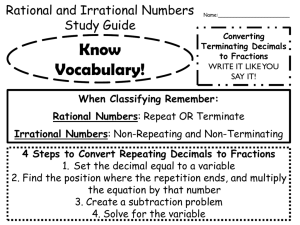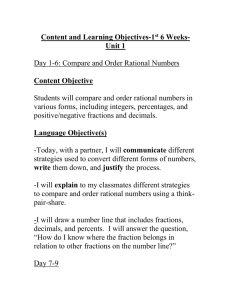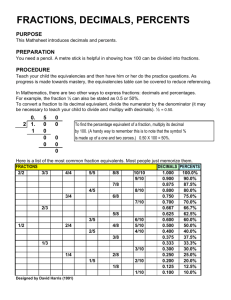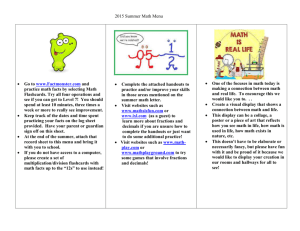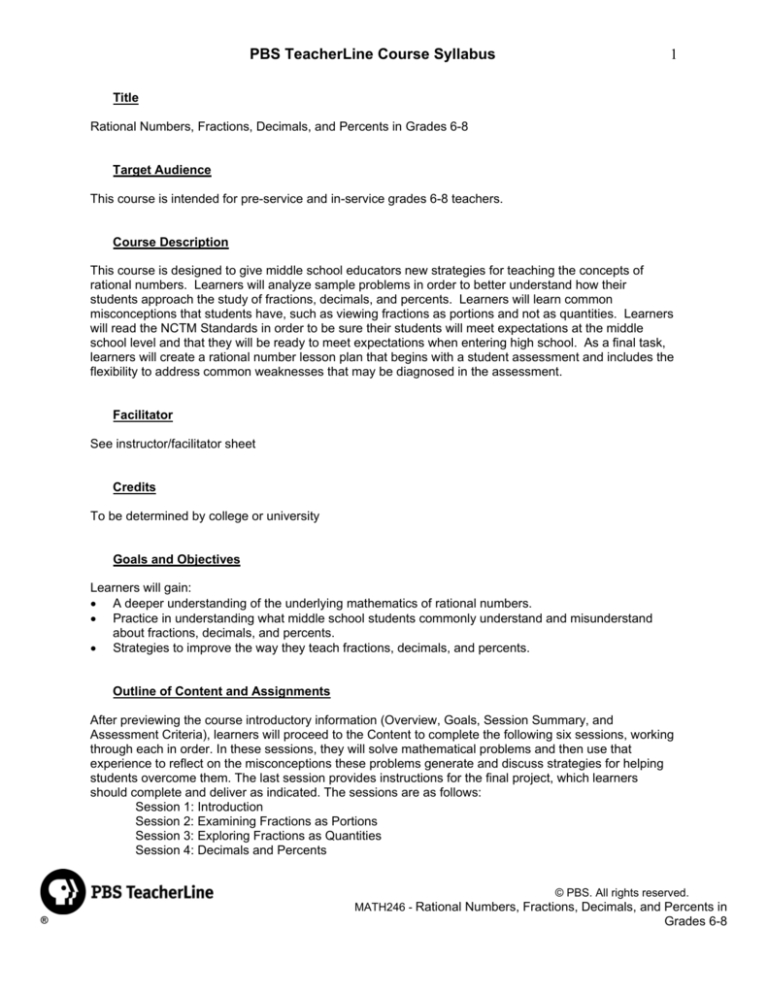
PBS TeacherLine Course Syllabus
1
Title
Rational Numbers, Fractions, Decimals, and Percents in Grades 6-8
Target Audience
This course is intended for pre-service and in-service grades 6-8 teachers.
Course Description
This course is designed to give middle school educators new strategies for teaching the concepts of
rational numbers. Learners will analyze sample problems in order to better understand how their
students approach the study of fractions, decimals, and percents. Learners will learn common
misconceptions that students have, such as viewing fractions as portions and not as quantities. Learners
will read the NCTM Standards in order to be sure their students will meet expectations at the middle
school level and that they will be ready to meet expectations when entering high school. As a final task,
learners will create a rational number lesson plan that begins with a student assessment and includes the
flexibility to address common weaknesses that may be diagnosed in the assessment.
Facilitator
See instructor/facilitator sheet
Credits
To be determined by college or university
Goals and Objectives
Learners will gain:
• A deeper understanding of the underlying mathematics of rational numbers.
• Practice in understanding what middle school students commonly understand and misunderstand
about fractions, decimals, and percents.
• Strategies to improve the way they teach fractions, decimals, and percents.
Outline of Content and Assignments
After previewing the course introductory information (Overview, Goals, Session Summary, and
Assessment Criteria), learners will proceed to the Content to complete the following six sessions, working
through each in order. In these sessions, they will solve mathematical problems and then use that
experience to reflect on the misconceptions these problems generate and discuss strategies for helping
students overcome them. The last session provides instructions for the final project, which learners
should complete and deliver as indicated. The sessions are as follows:
Session 1: Introduction
Session 2: Examining Fractions as Portions
Session 3: Exploring Fractions as Quantities
Session 4: Decimals and Percents
© PBS. All rights reserved.
MATH246 - Rational Numbers, Fractions, Decimals, and Percents in
®
Grades 6-8
PBS TeacherLine Course Syllabus
2
Session 5: Fraction-Decimal-Percent Connection
Session 6: Final Project
Session I: Orientation
Learners will:
Test their computers
• Install all required plug-ins to run PBS TeacherLine courses
Become familiar with the course Web site
• Download a copy of the learning log, used to describe how the math problems presented in
this course were solved
• Open the learning log to get acquainted with the kinds of questions that learners will answer
throughout the course
Read
•
"Linear Frameworks" By Catherine Twomey Fosnot and Maarten Dolk (excerpted from Young
Mathematicians at Work: Constructing Fractions, Decimals, and Percents).
Watch
• a short, informative video about preparing themselves to think like a learner as well as a
teacher for this course
• "Teacher Reflections," to meet one teacher and learn about her experiences with students
Collaborate
• Introduce themselves on the discussion board
• Learn how to communicate by posting messages on the board
Respond in the Online Journal
• Expectations for the course
• Prior knowledge of the content
Session 2: Examining fractions as portions
Learners will:
Read
•
•
“The Math Congress." This article from Young Mathematicians at Work: Constructing
Fractions, Decimals, and Percents describes a partitioning task and different ways used by
two groups of students to solve the task.
"Modeling Actions and Situations." This article from Young Mathematicians at Work:
Constructing Fractions, Decimals, and Percents illustrates the difference between partitive
division or fractions (a sharing model) and quotative division (measurement).
Analyze
• Student misconceptions with equal sizes of fractional parts
• Whole-Part-Fraction problems
• The Area and Length Models problem
• The Ohlsson Five-Quantity Method
View videos
• “Fraction Comparisons”
© PBS. All rights reserved.
MATH246 - Rational Numbers, Fractions, Decimals, and Percents in
®
Grades 6-8
PBS TeacherLine Course Syllabus
3
Record in their learning log
• After viewing the “Fraction Comparisons” video, learners will take notes and identify each
instructional approach as procedural or conceptual and explain which approaches do more to
show the students’ understanding of fractions.
• After reviewing the “Whole-Part-Fraction” problems, learners will respond to four questions
focused on the learning of fractions.
• After reviewing the “Area and Length Models” problem, learners will write about the
importance of recognizing alternate interpretations of area models for fractions.
Participate in the online discussion
• Upon completion of all the assignments and readings, learners are to go to the discussion
board and share ideas regarding their view on using the “Ohlsson Five-Quantity Model” with
middle school students.
Session 3: Exploring Fractions as Quantities
Learners will:
Read
•
“Understanding Fraction Amounts.” This article from Making Meaning for Operations
Casebook, Developing Mathematical Ideas: Number and Operations, Part 2 describes
research about student use of fractional notation to understand fractions.
Complete activities
• “Fraction Strips”
• “Number Line.” This Web-based interactive presents a dynamic number line to be used to
explore fractions.
View
•
The “Fractions” video. This video presents a situation that can cause student misconceptions.
Record in their learning log
• After completing the math activities, learners will describe the benefits these activities may
have on deepening students’ understanding of fractions.
• After watching the video, learners will write about student assumptions.
Participate in an online discussion
• After completing the readings, math activities, and learning log entries, learners will go to the
discussion board and share ideas for when students ought to have an understanding of
fraction notation based on the content of the session.
Session 4: Decimals and Percents
Learner will:
Read
•
•
"Generalising Whole Number Place Value Properties." This article, from the Teaching and
Learning About Decimals project at the University of Melbourne (Australia), describes some
important concepts basic to decimals and the difficulties some students have with those
concepts.
"Unitising.” This article, also from the University of Melbourne, discusses the difficulty of
unitizing.
© PBS. All rights reserved.
MATH246 - Rational Numbers, Fractions, Decimals, and Percents in
®
Grades 6-8
PBS TeacherLine Course Syllabus
Solve
•
4
Two common problems that test students’ understanding of decimals. These are:
o The “Number Expansions” problem
o The “Squares and Strips” problem
Participate in the online discussion
• After completing all readings and activities, learners will go to the discussion board and
discuss student knowledge of percents and ways to modify or extend an activity to deepen
student understanding of percents.
Session 5: Fraction-Decimal-Percent Connection
Learners will:
Read
•
Solve
•
•
•
"The Decimal-Fraction Link." This article, from the Teaching and Learning About Decimals
project at the University of Melbourne (Australia), describes the difficulties students have
connecting decimal and fractional representations and ways in which the same cognitive
difficulties in working with one representation can cause similar difficulties in working with the
other representation.
Converting among the forms (fractions-decimals-percents)
“The Abacus” activity
“Decimals to Fractions” problem
Record in their learning log
• After completing math activities, learners will describe methods for solving conversion
problems and any insights gained into the process of making these conversions.
• Learners will write about bringing meaning to the conversion process for the learner and for
students, and when to teach students about certain decimal and fraction equivalents.
Participate in the online discussion
• After completing all readings and activities, learners will go to the discussion board and share
ideas for guiding or directing a classroom discussion focused on appropriate uses of
fractions, decimals, or percents in the world.
Session 6: Final Project
Learners will:
Read
•
•
PSSM 2000 Number and Operations Standard, Grades 3-5. This standard will help learners
to understand what students in grades 3-5 are expected to understand about fractions,
decimals, and percents.
PSSM 2000Number and Operations Standard, Grades 6-8. This standard will help learners
to understand what students in grades 6-8 are expected to understand about fractions,
decimals, and percents. Learners should think about the misunderstandings that students
may have about rational numbers when transitioning between elementary school and middle
school mathematics.
© PBS. All rights reserved.
MATH246 - Rational Numbers, Fractions, Decimals, and Percents in
®
Grades 6-8
PBS TeacherLine Course Syllabus
5
Complete
• Sample State Assessment Problems - “How Fractions, Decimals, and Percents Appear on
State Assessments”
Participate in the online discussion
• After completing all readings and activities, learners will go to the discussion board and share
ideas on various methods for solving a problem that is then shared with students.
Final Project
Learners will complete the following assignment and submit the project to the facilitator. Learners will
write a short unit reviewing rational numbers that focuses on the number sense that students need to
have before moving on to a unit where they are introduced to operations. (Learners should include notes
for the teacher so that another teacher would be able to use this unit successfully) The unit will include:
• A pre- and post-test that can be used to determine students' weaknesses in their
understandings of rational numbers, with notes about what wrong answers may indicate
• At least one review activity for each representation (fraction, decimal, and percent)
• At least one activity addressing equivalence and comparison among the representations
• Notes about optional ways to address common weaknesses that may be diagnosed from the
pre-test
• Plans for what to do with any student whose number sense is not strong enough to
understand the operations work, even after the review activities
Submit the paper, lesson plan, and samples of student work (if possible) to the facilitator.
Record in their Online Journal
• Respond to the following question: What one or two ideas from this course will be of most
use to you in your classroom and why?
• Goals Achieved and Acquired Knowledge
Schedule
This course is scheduled to take approximately 15 hours to complete readings, activities, video,
assignments, reflections and a final project.
Requirements
Learners are expected to:
• Complete all assignments
• Maintain an online journal
• Participate regularly in discussion boards
Materials (hardware, software, plug-ins)
Technical Requirements
• Word processor
• Internet service provider
• E-mail
© PBS. All rights reserved.
MATH246 - Rational Numbers, Fractions, Decimals, and Percents in
®
Grades 6-8
PBS TeacherLine Course Syllabus
6
Academic Dishonesty Policy
To be inserted by university institution only
Evaluation
This course is evaluated on a letter grade basis, and may be available for graduate credit. See graduate
credit details pertaining to specific graduate credit institutions.
© PBS. All rights reserved.
MATH246 - Rational Numbers, Fractions, Decimals, and Percents in
®
Grades 6-8



